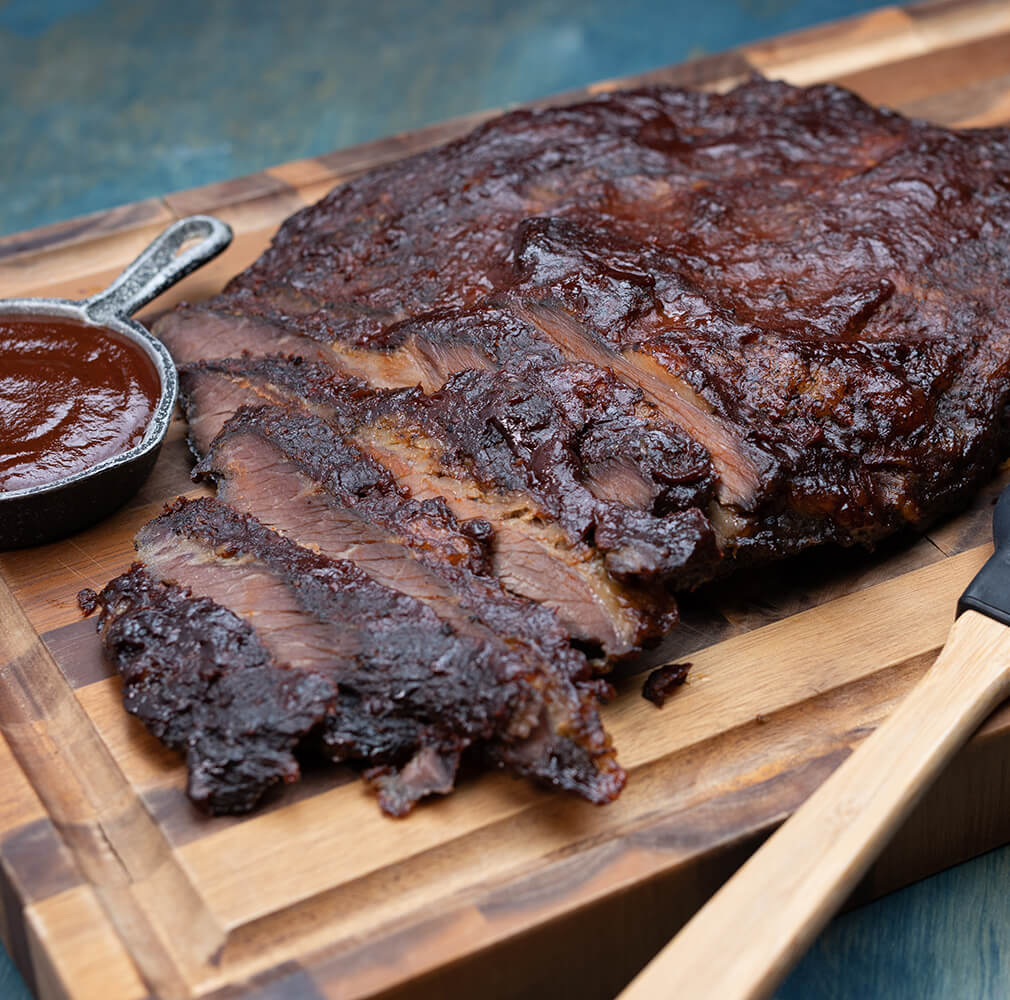Welcome to Brisket 101, your beginner’s guide to getting to know this beautiful cut of beef. If you’re on this page, you likely are searching for info on smoking the most luscious and tender piece of brisket possible and I am here for you! In today’s post, we’re starting with the basics: What is a brisket and where is the best place to purchase one? Step into my virtual classroom and I’ll share everything you need to know to smoke a brisket that is even better than your favorite BBQ restaurant.
I LOVE beef brisket. It might honestly be one of my favorite cuts of beef to eat and definitely the most rewarding to smoke. The process of smoking a full brisket is long, but believe me when I say it is completely worth it. Since it is such a time-intensive smoke, I want to you be thoroughly prepared and confident before you even turn on that grill.
I’ve smoked a lot of briskets over the last several years, each one better than the last. I’m going to share all that I’ve learned about the basics of beef brisket so you can smoke your very own brisket like a seasoned pitmaster. Join me as I take you step-by-step through the entire brisket process from start to finish.
Brisket is a cut of beef from the chest of the animal that is a relatively tough cut of meat. A full brisket is made up of two muscles that overlap. The thickest part of the brisket is called the “point” and the thinner, more uniform part of the brisket is called the “flat”. The point is often more heavily marbled with fat and is often called “fatty brisket” in BBQ joints. The flat is less fatty and called “lean” in restaurants.
After trying brisket from several different restaurants and making my own dozens of times, I know my favorite piece of brisket is absolutely a thick slice from the fatty point. I recommend going to your favorite BBQ restaurant and asking for a slice of the lean brisket and a slice of the fatty brisket to help you decide what you really like. If you’ve ever heard of Brisket Burnt Ends, they are often made from the fatty point of the brisket.
An uncooked brisket comes in many shapes and sizes at grocery stores and butcher counters. It can also be labeled in several different ways. Most of the time in your local grocer, you will see a small brisket (3-5 lbs) wrapped in cellophane that has had a majority of the fat trimmed away. These smaller brisket pieces are great for my Drunk Brisket Recipe or if you’re short on time or serving just a few people, but they are not what you’re looking for if you want that smokehouse brisket experience like with my Texas Style Brisket Recipe.
Beef brisket is a large cut of meat from the breast or the lower chest of a cow. It is one of the nine beef primal cuts and one of the four main barbecue meats. It is a relatively tough piece of meat because the animal works it while moving.

What Part of the Cow is Brisket?
First and foremost, brisket is a set of two overlapping muscles that run along the chest of the cow. This pectoral muscle does a lot of heavy lifting (literally). The animal uses it to walk, run, push itself off of the ground, etc. Since this muscle is regularly used, it is a very tough cut of meat laced with tight connective tissue.
These qualities make the brisket a terrible cut of meat for slicing like a steak, but the same qualities make it perfect for the low and slow love and dedication of a good smoke. The slow and steady climb in temperature and exposure to wood smoke tenderizes this stringy muscle, breaks down that tight connective tissue, and seals in all of the rich beefy flavor. If you’ve ever had really good brisket, you will always have a little place in the back of your mind that craves it.
Aaron Franklin describing how he trims a brisket at Brisket Camp 2015
FAQ
How would you describe beef brisket?
What are the words related to brisket?
Why do people like brisket?
What is beef brisket?
Beef brisket is the iconic barbecue meat. Pitmasters around the world prides themselves on their prized briskets, and you can too with our dedicated hub to the world’s best cut of beef. Find out everything that goes into the perfect plate of brisket with our how-to guides, easy recipes, and in-depth gear reviews.
Brisket flat vs Point: Which is healthier?
Brisket is the cut of meat from the chest or breast. A flat cut is much leaner cut with a layer of fat at the bottom. Usually in the super markets flat cuts are seen. The point cut has a lot of fat running through it when cooked the meat comes out to be more juicy. If you are looking for a brisket that will slice up nicely flat cut is your best bet.
What is a brisket cut?
A brisket is a lean, tough muscular cut that doesn’t consist of very much fat marbling throughout the meat. The pectoral muscle is full of connective tissues, elastin and collagen, that are incredibly tough. As such, they require a long and slow cook on low temperatures in order to properly break down the connective tissue and tenderize the meat.
Where does brisket come from?
Brisket is a cut of beef that comes from the lower breast or pectoral muscles of a cow. Because this area is so well-exercised, it makes for quite a tough piece of meat that’s full of connective tissue. This is why it’s best suited towards a low and slow cooking process.
